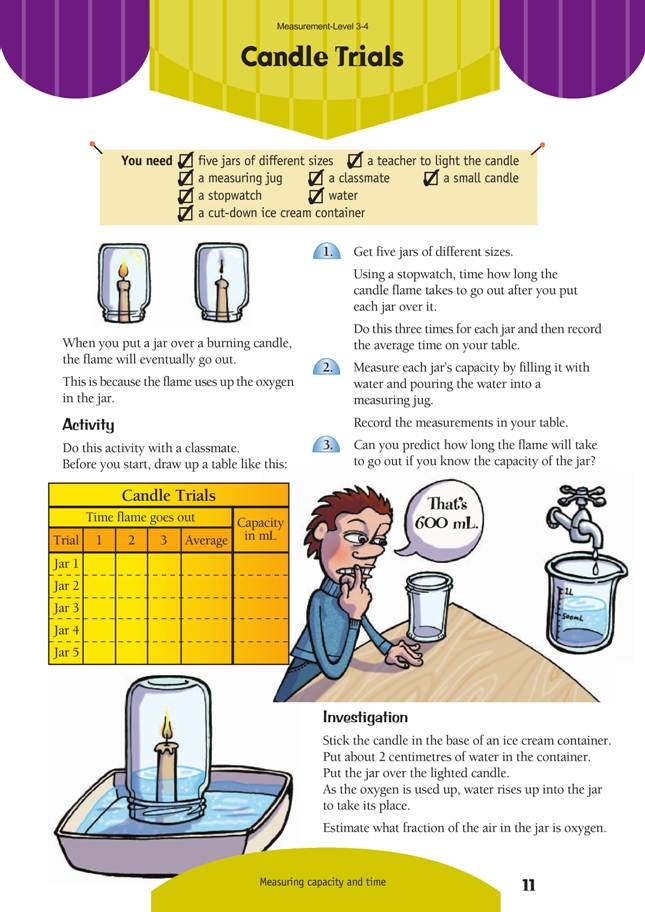This is a level 3 measurement activity from the Figure it Out series.
A PDF of the student activity is included.
Click on the image to enlarge it. Click again to close. Download PDF (300 KB)
carry out a scientific experiment involving measuring
tape measure
scales
FIO, Level 3-4, Measurement, Candle Trials, page 11
measuring jug
stopwatch
This activity provides a scientific context for students to develop and apply statistics skills. Some careful preparation is necessary:
- Ensure that the working surface is smooth and level. A small whiteboard laid on some desks works well.
- Use food colouring to make the water level easier to observe.
- Remove labels from the jar so that observation is unimpeded.
- Place the candle on a lid that is smaller than the tops of the jars so that the jar can fit over it. The lid will collect any drips from the candle and can also be used to help stick down the candle if it is wobbly.
- Cut the candles so that they are smaller than the jars being used, but they should be at least 5 centimetres in height.
The students could work in groups of three or four, with designated tasks to encourage safe practice:
- a responsible person to light the candle (or you may do this)
- a person to place the jar over the candle
- a person to time the activity with a stopwatch, from placing the jar until the flame goes out
- a person to record the results on a table.
Ensure that the students realise that the flame went out because it had used all the oxygen that was in the air.
Question 3 develops higher order thinking by applying the results of the previous work. The students can use their previous results to find the rate, in millilitres per second, at which the candle uses the oxygen in the air. For example, if the candle in a 700 millilitre jar went out in 23 seconds, the rate would be 700 ÷ 23, which is approximately 30 millilitres per second. This rate could then be used to estimate the time taken for other jars.
| Jar size | Rate | Estimated time taken |
|---|---|---|
| 150 mL | 30 mL per second | 5 seconds |
| 300 mL | 30 mL per second | 10 seconds |
Investigation
Once the jar is in position, the students should carefully watch the water level inside the jar. They may notice that at first it drops a little as the flame adds some water vapour and carbon to the inside of the jar as well as expanding the gas in the jar by heating it.
The level will then rise up and stop rising 1 or 2 seconds after the flame goes out. Make sure that the students mark the height of the water in the jar before lifting out the jar. They should see that the water has risen approximately 1/5 of the way up the jar. This is the amount of oxygen that has been removed from the air by the burning candle. This shows that air contains 1/5 or 20% oxygen. Most of the rest is nitrogen.
IMPORTANT NOTE: The explanation for the investigation is an oversimplification of the science involved. Oxygen is not removed from the air, it is converted to other molecules.
